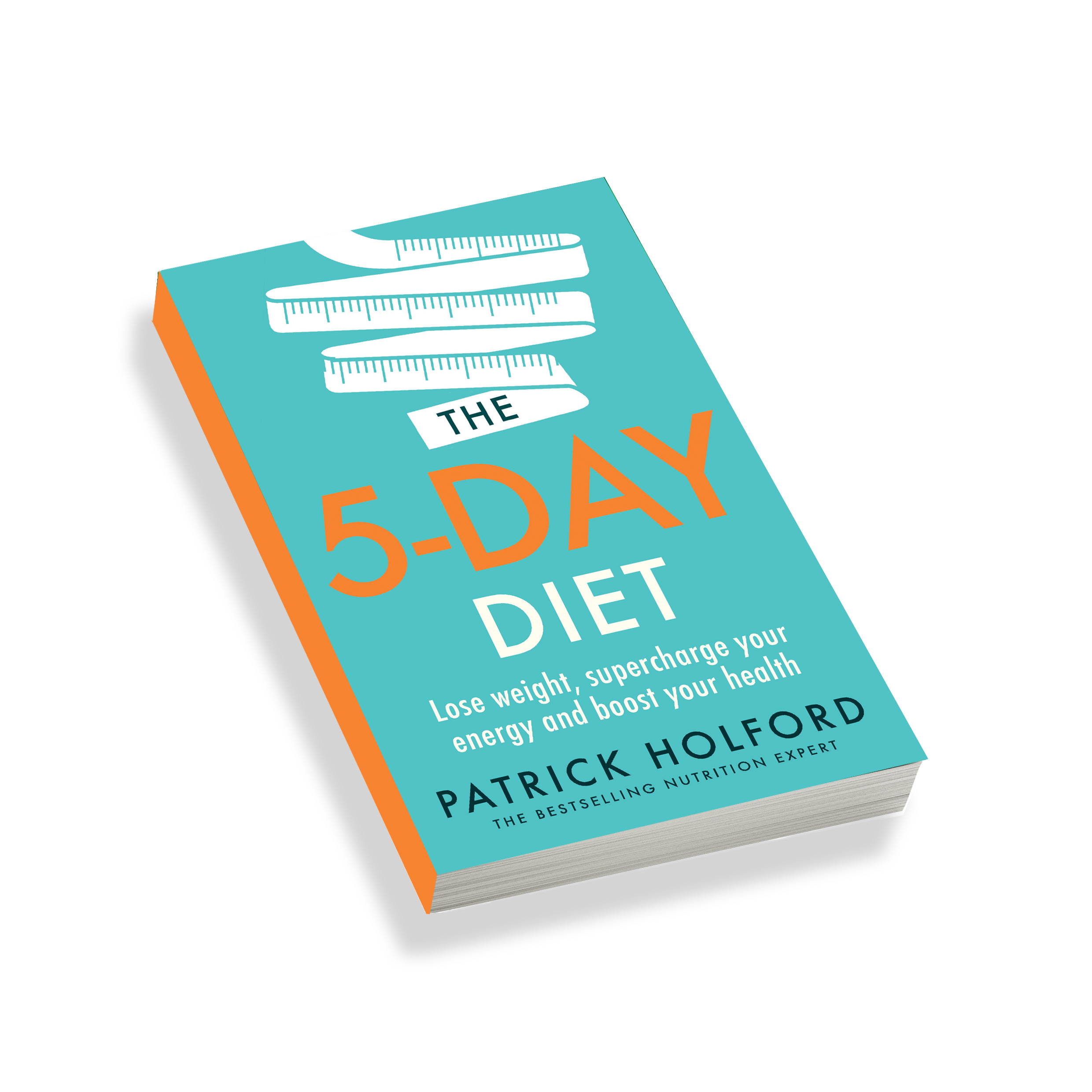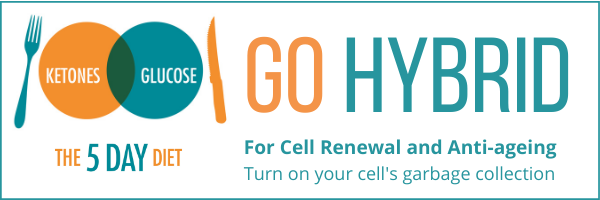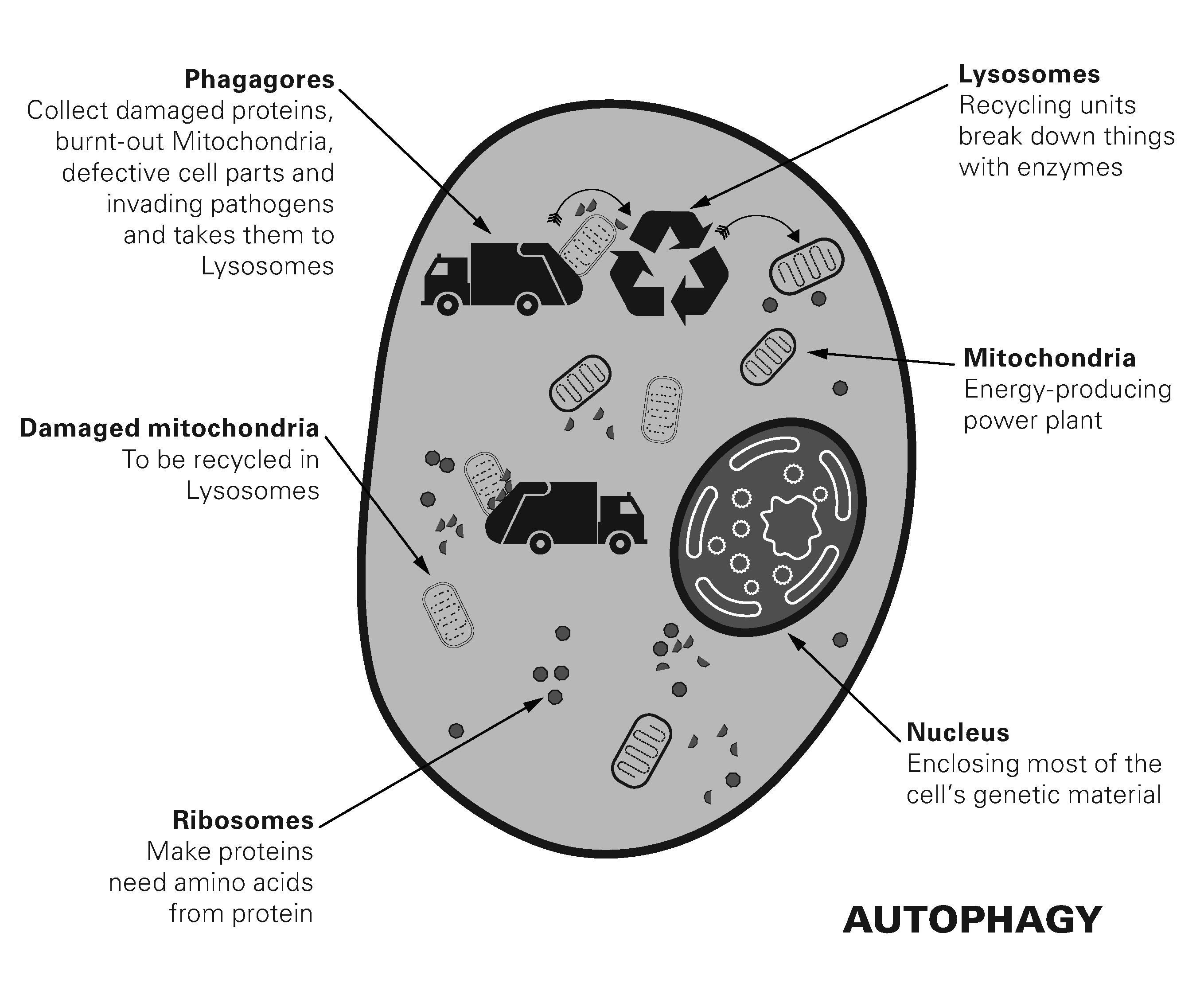When Ohsumi started researching autophagy, there were fewer than 20 papers published each year on the subject; now there are more than 5,000 each year, as it is the subject of diverse fields including cancer and longevity studies. There’s now a large body of research that connects fasting with improved blood sugar control, reduced inflammation, weight loss and improved brain function.
How to explain this discovery – in a way that is accessible – has been my focus over the last few years and resulted in the publication of two books. In this report I focus on why Going Hybrid effects cell renewal and has an anti-ageing effect.
Going Hybrid FOR ANTI-AGEING
Cell renewal and normalisation of blood sugar levels adds up to a profoundly anti-ageing effect, with better production of stem cells – the foundation cells from which we develop new cells from skin to brain cells.
When cells are starved (autophagy) they break down proteins and other cell components and use them for energy. During autophagy cells destroy viruses and bacteria and get rid of damaged structures. It’s a process that is critical for cell health, renewal and survival. Here I explain the process in more depth.
Cellular Clean-up
Manufacturing and energy generation create as much waste and junk on the nano-scale, within cells, as they do on the macro-scale, in our global environment. Therefore, an efficient rubbish-removal system for each of our billions of cells is essential if our bodies are to continue functioning properly.
The one we have – which is known as autophagy (literally ‘self-eating’) – not only hoovers up dead and damaged proteins but also disposes of much larger units, including burned-out mitochondria. All this waste matter is then tipped into a pit that is brimming with enzymes, where much of it is recycled into fresh energy supplies and the raw materials to create new proteins.
When you start a ketogenic diet, the sharp drop in carbohydrates immediately triggers the starvation response. As the levels of glucose and insulinInsulin is a hormone made by the pancreas. It is responsible for making the body’s cells absorb glucose (sugar) from the blood…. in the blood start to decline, the body’s mTOR network – which promotes cell growth when supplies of glucose are high – switches off and autophagy redoubles its collection and recycling efforts. These are just two of the mechanisms that are involved in losing or gaining weight, sending fuel around the body and growing new cells.
Crucially, they cannot function simultaneously: when the mTOR network starts, autophagy stops, and vice versa. Understanding how the whole system works will give you a better chance of making it work well for you.
The Cell Waste Removal System
Millions of microscopic bin lorries called phagophores collect the accumulated rubbish. These ever-expanding trucks trundle around the body’s cells, engulfing dead or damaged proteins, bacteria, viruses and exhausted mitochondria as they go. Next, they transport all of the waste products and foreign bodies they have collected to the lysosome – a large bubble filled with enzymes that dissolve proteins into their constituent amino acidsAmino acids are commonly known as the building blocks of protein. There are 20 standard amino acids from which almost all proteins are made. Nine…. These can become a valuable extra source of fuel for the mitochondria or provide the raw materials for new proteins, which are manufactured in the cells’ ribosomes. However, if the body continues to starve – and energy remains in short supply – the ribosomes themselves may be broken down into their component amino acids to provide some emergency fuel for the mitochondria.
When the crisis is over – either because glucose supplies have been restored or ketones are now available – growth resumes and the recycled amino acids are once again turned into new proteins.
Autophagy’s crucial role in keeping the body supplied with fuel is sometimes evident right at the beginning of life. If the supply of food from the mother stops for any reason, the baby is able to function perfectly well – for a time – on amino acids produced during autophagy. Then, later in childhood, autophagy alternates with mTOR activation to ensure that the growth process proceeds smoothly.
However, once we are fully grown, the body benefits from spending more time in the autophagy (clean-up) phase and less time in the mTOR (growth) phase.
One of the best ways to achieve this is simply to eat less, possibly by going on a calorie-controlled diet. As early as the 1930s, it was discovered that animals that are fed 30 per cent less than normal are very healthy with good metabolic markers, such as low blood pressure, low glucose and insulin, and a healthy body mass index.
Moreover, in addition to providing emergency energy supplies, autophagy seems to offer some protection against brain disorders, including Parkinson’s disease. Neurons use a lot more energy than other cells, so the brain’s mitochondria need to be especially efficient.
However, as we age, the mitochondria’s system for mopping up the oxidants that are released during energy production starts to deteriorate and DNA can be damaged as a result. Fortunately, though, as we have seen, autophagy weeds out the worst mitochondria before they can do too much harm. This is just one of the reasons why it’s so important to kickstart the repair process on a regular basis.
Another is that cancerous cells find it harder to multiply and spread during autophagy. This is because phagophores quickly identify the defective cells, hoover them up, and deposit them in the lysosome, where they are broken down. In addition, ‘Autophagy limits oxidative stress, chronic tissue damage, and oncogenic [cancer cell] signalling, which suppresses cancer initiation.’
Unfortunately, if a tumour is given the chance to establish itself, the balance of power may shift, as it will be able to use the amino acids that are produced during autophagy as fuel to meet its very high energy demands and expand into surrounding territory.
It’s possible that inadequate or malfunctioning autophagy is also a factor in the development of Alzheimer’s, given that the condition is characterised by a build-up of plaque and other waste products in the brain. Indeed, recent research suggests that a wide range of illnesses may be linked to damaged mitochondria that have lost the ability to burn fatThere are many different types of fats; polyunsaturated, monounsaturated, hydrogenated, saturated and trans fat. The body requires good fats (polyunsaturated and monounsaturated) in order to… or glucose efficiently. A case in point is chronic fatigue syndrome, in which energy production is obviously compromised. As such, it is imperative to keep clearing out the worst-performing mitochondria through autophagy.
However, autophagy itself tends to become less efficient as we get older, probably because the body’s lysosomes lose some of their ability to recycle amino acids.
Is the Ketogenic Diet -and/or fasting the answer?
The ketogenic diet – and/or fasting – might provide the answer because it pushes the body into autophagy on a much more regular basis and therefore forces the lysosomes to keep working. This is one reason why the approach has been proposed as a treatment for chronic fatigue syndrome.
The pharmaceutical industry and medical researchers are currently exploring ways to improve lysosomes’ performance through genetic engineering and developing ever more powerful drugs to block mTOR.
However, I believe that Going Hybrid is a much more natural way to achieve the same goals. As you switch from a high fat to a slow carb diet, then back again, your system cycles through predictable, controllable periods of growth (more cells, more muscle mass, more troops for your immune system) and periods of clean-up and repair (when autophagy is the key player). It’s what we have evolved to do.
Extracts from The Hybrid Diet (Piatkus, 2019). References for the book available on The 5 Day Diet page under The Science and Testing.
THE 5 DAY DIET
One way to get into ketosis is by fasting. The trouble is only the brave are willing to do it. There are many variations of intermittent fasting. All these have their merits and reasonable evidence, or at least logic, to support them. All will have the potential to briefly trigger autophagy and nudge your metabolismMetabolism is a term that is used to describe the chemical reactions that take place within the body’s cells. The body gets the energy it… away from glucose, made from carbs, towards ketones, made from fat, including burning your own body fat.
Yet I do not believe that they are nearly as effective as five consecutive days of fewer calories, with not too much proteinProteins are large molecules consisting of chains of amino acids. Proteins are essential nutrients for the human body – they are a building block of…, and consuming food and drink that is specifically designed to trigger autophagy – which is the key to the ability of fasting to transform your health, rejuvenate your cells and switch you out of a disease process.
In 2019 I wrote the book The Hybrid Diet, with award-winning medical journalist Jerome Burne explaining the theory and some practical information so you could create your own diet. I followed it up in 2020 with the more prescriptive 5 Day Diet. We’ve now run three groups of people following this diet, measuring weight and body fat. In each group the average weight loss was close to 3kg each, roughly 7lbs, almost all of which was fat. In the last 5 Day Diet retreat experiment the greatest loser lost 11lbs. This kind of healthy weight loss is unheard of. No diet – 5:2, keto, low carb, 18:6, weekly fasting even conventional FMD has achieved this, also with no hunger.

If you think you’d like to try a diet based on this new science, then take a look at my 5 Day Diet book which summarises the science while giving you daily meal plans, recipes, a supplement programme and exercises. The diet has been devised to help you kickstart ketosis, lose weight, gain energy and transform your health in just five days. The book is available from HOLFORDirect – FREE with the supplement combo needed to get cracking with the diet – or you the book is available on its own.
5 -DAY DIET TESTIMONIALS
If you want to read what others who have done the diet have to say about it you can read their testimonials here.
5 DAY DIET RETREATS
Details of the retreat are on my retreat events page.
Details of the room options are found at Holford Natural Holidays.



Comments
Join the Conversation on our Facebook Page